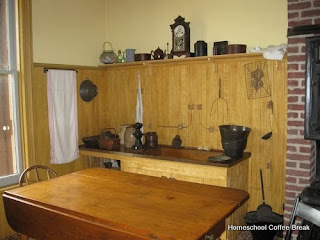While on vacation last week we took one day to visit the Genesee Country Village and Museum near Rochester, NY. As we arrived at the tollhouse, we were lucky enough to happen on a school/camp group that were doing some Civil War re-enactment. We were even more lucky in that none of us got caught in the cross-fire. ;-)
The village itself is in three "sections" - a Pioneer Settlement, an Antebellum Village, and a Turn of the Century area. The Pioneer Settlement area includes houses and a farmstead, a Quaker meeting house, a schoolhouse, blacksmith shop and brewery. The Antebellum Village contains the most buildings at the museum, and we didn't have time to see all of them. There are many houses and a farm, tradesman shops (wainwright, potter, cooper, dressmaker, cobbler, tinsmith, gunsmith), churches, general stores, physician's office, inn, post office, printing office... And from the Turn of the Century era, a few houses and the opera house. There is also a Silver Base Ball Park, with a turn-of-the-century style field where tournaments with late 1800s rules are played. In fact, there was a tournament scheduled to start two days after our visit, along with the annual Laura Ingalls Wilder Days.
 |
| schoolhouse, c. 1822 |
 |
| lesson plan from the 1800s |
 |
| kitchen area of an 1809 farmhouse |
The blacksmith shop (c. 1830) was interesting - and HOT - and the master smith explained much of their work and also told us about many words and phrases that originated with the blacksmith's trade. Things like "strike while the iron is hot", trademarks, brand-new, and many others.
 |
| W. Greive's Brewery, c. 1803 (reconstructed) |
Landon took a turn helping the brewer, this simple crank machine cracked the hulls from the barley or something like that. (You can tell I was paying attention! Guess I should have taken notes)
Silver Base Ball Park
 |
| Hamilton Place, c. 1870 |
Isn't this stove (in Hamilton Place kitchen) beautiful? The kitchen in this house had every 'modern convenience' for the time period, and was a beautiful room with large windows and work spaces. Even the kitchen sink was attractive!
This is the octagon house. Apparently they were fairly popular at the time because they were very efficient for heating and cooling and in use of space. Not many examples remain today, however. We were told that their shape made heating extremely efficient, the same design essentially turned the entire building into a "chimney" which also made it a fire hazard. I didn't take any pictures inside the house, but it was beautiful and surprisingly spacious.
 |
| Hyde House, c. 1870 |
 |
| Davis Opera House, 1884 |
The Opera House was on the second floor of the pharmacy and general store.
 |
| Jones Farmhouse, c. 1820 |
The walls inside this farmhouse were all covered with beautiful stenciling.
Kennady tried her hand at churning butter. And... we learned a little something about housekeeping during that time period which made ME feel a whole lot better about my own poor housekeeping habits. ;-) I can't get the picture above large enough to be readable here, so I will quote from the sign:
The early 1800s rarely saw American houses the neat and meticulously presented examples seen in restored historic homes and villages. ...In the countryside, women struggled to keep order, but inundated with the daily tasks of farm households most ignored the dirt. Travelers found dirt and litter on the floors, and household belongings in disorderly piles. Housewives tossed broken vessels and trash out the most convenient door or window, and threw bones and food scraps into the yard to be picked over by pigs and chickens. (emphasis mine! LOL)
 |
| chandelier in Brooks Grove Methodist Church, c 1844 |
We were treated to a "concert" on the pump organ at the Brooks Grove Methodist Church. We have a pump organ at our house that Kennady likes to play so this was interesting.
 |
| Livingston-Backus House |
The cook was preparing for the lady of the house to have guests for tea. This table was laden with tarts and pastries as well as this gorgeous cake adorned with sugared flowers.
At the tinsmith's, the kids punched a tin Christmas ornament.
 |
| tinsmith shop, c. 1860 |
Flint Hill Pottery, c 1845 (reconstruction)
I hope you've enjoyed "visiting" the Genesee Country Village and Museum with us! If you're in the Rochester area, visit in person and I'm sure you will enjoy it!
Don't miss a coffee break! Subscribe to Homeschool Coffee Break by Email!
©2006-2018 Homeschool Coffee Break. All rights reserved. All text, photographs, artwork, and other content may not be reproduced or transmitted in any form without the written consent of the author.http://kympossibleblog.blogspot.com/
We are a participant in the Amazon Services LLC Associates Program, an affiliate advertising program designed to provide a means for us to earn fees by linking to Amazon.com and affiliated sites.










































































1 comments:
Yay! It's letting me comment without signing in to hsb.
What an awesome trip. I'm totally jealous.
Post a Comment
I love comments! It's like visiting over a virtual cup of coffee.